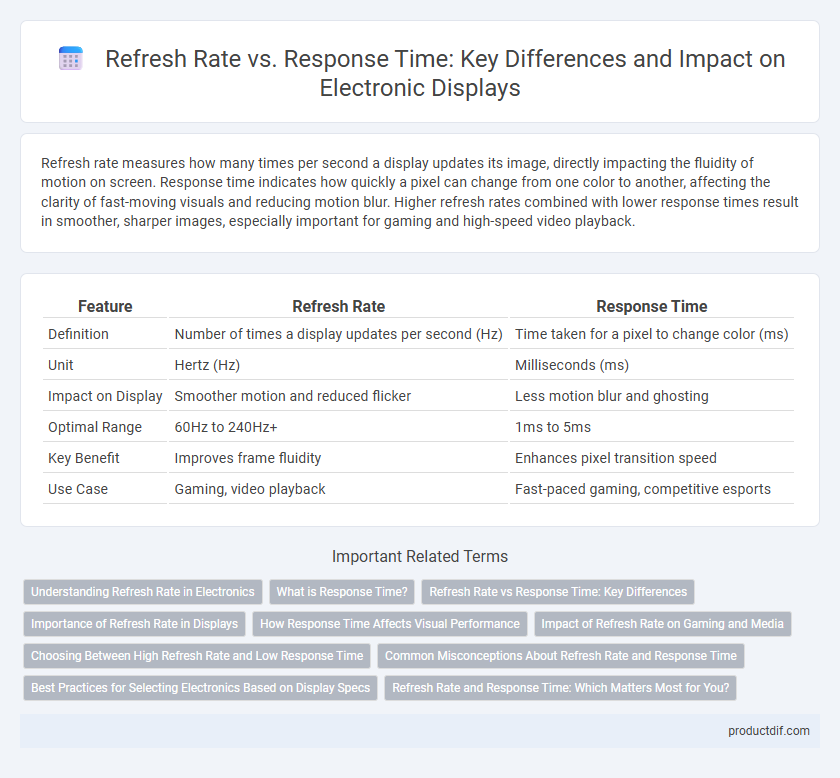Refresh rate measures how many times per second a display updates its image, directly impacting the fluidity of motion on screen. Response time indicates how quickly a pixel can change from one color to another, affecting the clarity of fast-moving visuals and reducing motion blur. Higher refresh rates combined with lower response times result in smoother, sharper images, especially important for gaming and high-speed video playback.
Table of Comparison
| Feature | Refresh Rate | Response Time |
|---|---|---|
| Definition | Number of times a display updates per second (Hz) | Time taken for a pixel to change color (ms) |
| Unit | Hertz (Hz) | Milliseconds (ms) |
| Impact on Display | Smoother motion and reduced flicker | Less motion blur and ghosting |
| Optimal Range | 60Hz to 240Hz+ | 1ms to 5ms |
| Key Benefit | Improves frame fluidity | Enhances pixel transition speed |
| Use Case | Gaming, video playback | Fast-paced gaming, competitive esports |
Understanding Refresh Rate in Electronics
Refresh rate in electronics refers to the number of times per second a display updates its image, measured in Hertz (Hz). A higher refresh rate, such as 120Hz or 144Hz, results in smoother motion and reduces screen flicker, enhancing visual clarity especially in fast-moving content like gaming or video playback. Understanding refresh rate is essential for evaluating display performance and choosing monitors that deliver fluid and responsive visuals.
What is Response Time?
Response time in electronics refers to the duration a pixel takes to change from one color to another, typically measured in milliseconds (ms). Lower response times reduce motion blur and ghosting, enhancing the clarity of fast-moving images on displays. This attribute is crucial for gaming monitors and video playback where quick image transitions improve visual performance.
Refresh Rate vs Response Time: Key Differences
Refresh Rate measures how many times per second a display updates its image, typically expressed in Hertz (Hz), while Response Time indicates how quickly a pixel changes from one color to another, usually recorded in milliseconds (ms). Higher refresh rates result in smoother motion and reduced motion blur, essential for gaming and fast-paced video content. Conversely, lower response times minimize ghosting and motion artifacts, improving visual clarity during rapid scene changes.
Importance of Refresh Rate in Displays
Refresh rate, measured in Hertz (Hz), is crucial for determining how many times per second a display updates its image, directly affecting motion smoothness and visual clarity. Higher refresh rates, such as 120Hz or 144Hz, reduce motion blur and provide a more fluid viewing experience, especially important in gaming and fast-paced video content. While response time impacts pixel transition speed, refresh rate primarily governs how seamlessly animations and movements are rendered on screens.
How Response Time Affects Visual Performance
Response time in electronic displays measures how quickly a pixel can change from one color to another, directly impacting motion clarity and reducing ghosting effects. Faster response times enhance visual performance by minimizing blur during fast-moving scenes, crucial for gaming and video playback. A low response time ensures smoother transitions, delivering a sharper and more immersive viewing experience.
Impact of Refresh Rate on Gaming and Media
Higher refresh rates, such as 120Hz or 144Hz, significantly enhance gaming experiences by delivering smoother motion and reducing screen tearing, which is crucial for fast-paced games. A higher refresh rate provides more frames per second, resulting in more fluid visuals and improved reaction times for players. While response time affects ghosting and motion blur, refresh rate primarily determines the overall smoothness and visual clarity in dynamic media playback and gaming environments.
Choosing Between High Refresh Rate and Low Response Time
Choosing between a high refresh rate and low response time depends on the primary use case in electronics displays. High refresh rates, such as 120Hz or 144Hz, deliver smoother motion and reduce screen tearing for gaming and fast-moving visuals. Low response time, typically measured in milliseconds, minimizes ghosting and blur, improving clarity in fast transitions but may be less critical than refresh rate for overall fluidity.
Common Misconceptions About Refresh Rate and Response Time
Many people mistakenly believe a higher refresh rate guarantees better response time, but these two metrics measure different aspects of display performance. Refresh rate, measured in Hertz (Hz), indicates how many times the screen updates per second, while response time, typically in milliseconds (ms), refers to how quickly a pixel changes color. Understanding this distinction helps consumers choose displays that balance smooth visuals with minimal motion blur and ghosting.
Best Practices for Selecting Electronics Based on Display Specs
Selecting electronics based on display specifications requires careful evaluation of refresh rate and response time to ensure optimal visual performance. High refresh rates, such as 120Hz or 144Hz, provide smoother motion rendering ideal for gaming and fast-paced video content, while low response times, typically under 5ms, reduce motion blur and ghosting for clearer images. Prioritize displays that balance a high refresh rate with low response time to achieve both fluid visuals and sharp image transitions, which enhances user experience in gaming, multimedia, and professional applications.
Refresh Rate and Response Time: Which Matters Most for You?
Refresh rate and response time are crucial factors in display performance, with refresh rate measuring how many times per second the screen updates, typically expressed in Hertz (Hz), and response time indicating how quickly a pixel changes from one color to another, measured in milliseconds (ms). A higher refresh rate, such as 144Hz or 240Hz, delivers smoother motion ideal for fast-paced gaming or video playback, while a low response time, like 1ms to 5ms, minimizes motion blur and ghosting, enhancing visual clarity during rapid movements. Prioritizing refresh rate benefits users seeking fluid visuals for competitive gaming, whereas response time is critical for eliminating lag and ensuring sharp image transitions in action-packed scenes.
Refresh Rate vs Response Time Infographic

 productdif.com
productdif.com